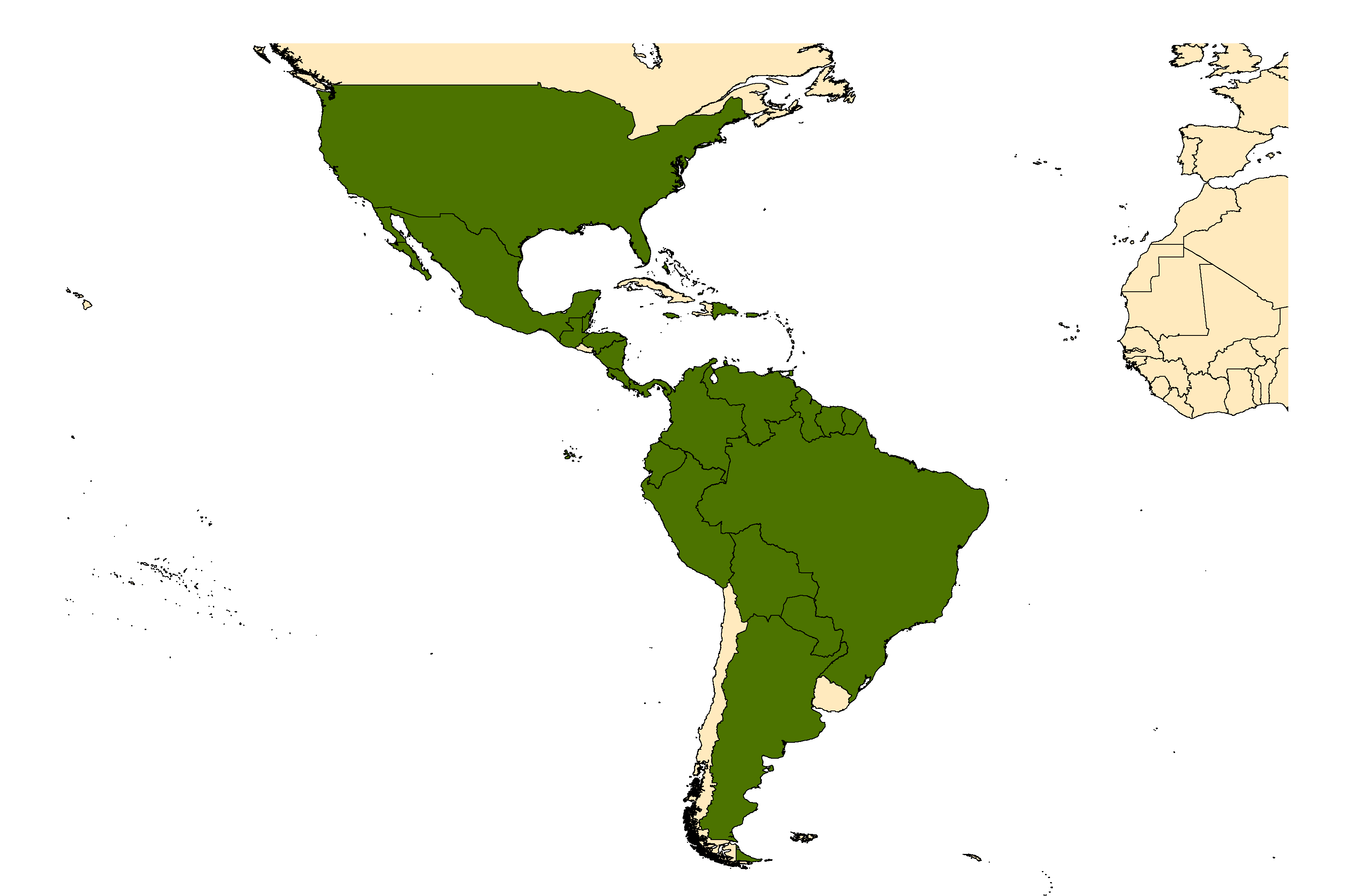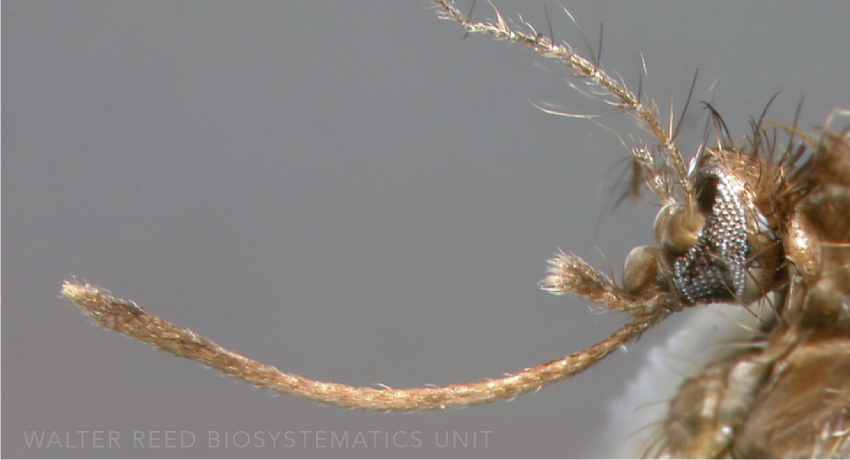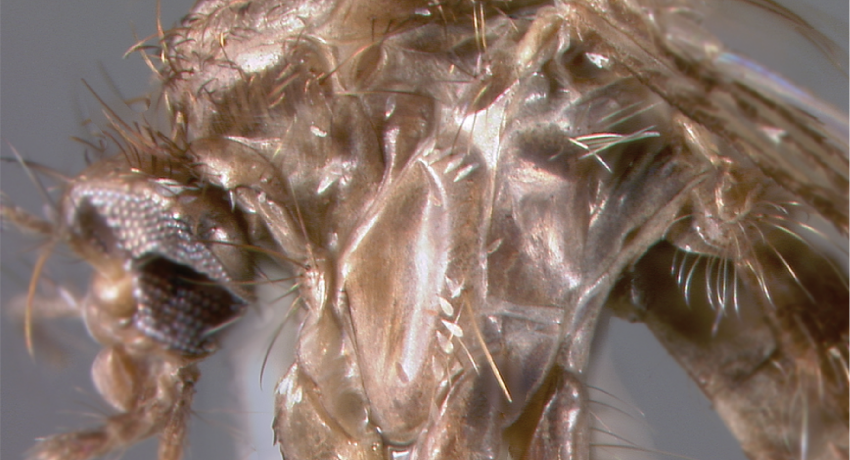NEOTROPICAL REGION
Etymology: banded legs or feet (Gr); legs “black, with broad white rings on the tarsi”
Culex taeniopus is the nominotypical member of the Taeniopus Group, which also includes Cx. akritos Forattini & Sallum, Cx. cedecei Stone & Hair, and Cx. ikelos Forattini & Sallum. The scutum of Cx. taeniopus bears long setae, and its pleuron has a light spattering of white scales. That Ta-III5 is entirely white in Cx. taeniopus distinguishes it from the morphologically similar species Cx. cedecei and the dark capitellum and lack of broad white spatulate scales in Cx. taeniopus differentiates it from Cx. akritos and Cx. ikelos.
Type locality: Bluefields, Nicaragua
Type depository: U.S. National Museum, Washington, D.C., United States (USNM)
DIAGNOSTIC CHARACTERS (Click photos to view; mouse over and click large photo to zoom in.)
ADULT (illustrated): Head: Proboscis entirely dark-scaled; decumbant scales of vertex and occiput narrow, dark medially, gray to white laterally. Thorax: Scutal scales mainly dark, some golden scales on prescutellar area; postspiracular area without broad white scales; upper mesokatepisternal scales broad and white; capitellum of halter dark. Legs: Ta-III1–4 with basal and apical white bands; Ta-III5 white.
LARVA (not illustrated): Head: Seta 1-C positioned at tip of projecting lobe of labrum. Thorax: Seta 3-P less than half length of 1-P. Terminal segments: Comb with comb scales small with even fringe at apex; siphon long, index about 17; seta 1-S with distal subdorsal tuft inserted near apex of siphon; seta 3-P less than half length of 1-P.
TAXONOMIC KEYS
None
![]()
WRBU – Culex (Mel.) - Neotropical Region – Larva
Exemplar DNA sequences
Cx. taeniopus COI: JX259916
BIONOMICS
Immatures
Culex taeniopus immatures are generally found at swamp and river margin margins. They are common in marshy lowland areas populated with Coquillo (Manicaria saccifera) and Silica (Raphia taedigera) palms in Venezuela. Studies in Jamaica (as opisthopus) and Florida, United States showed that immature survival decreases with increasing temperature.
Adults
Culex taeniopus preferentially feed on rodents, especially opossums (genus Didelphis), other species of bare-tailed marsupials (Marmosa and Caluromys sp.) and squirrels. Females will also feed on birds and people when they are outdoors. Female Cx. taeniopus are readily collected in CDC light traps and at human bait, with peak biting activity just before and just after sunset in most zones. However, biting activity in Trinidad and Tobago shows two distinct peaks—one at/after sunset (18:00–20:00) and the second between midnight and 02:00. Adults are strong fliers, recorded up to 7km from their emergence sites. Adult Cx. taeniopus rest in dense fully or partially shaded vegetation, and have been collected in humid rock fissures in coralline limestone scarps, as well as inside crabholes.
DISTRIBUTION NOTES
Argentina, Bahamas, Belize, Bolivia, Brazil, Cayman Islands, Colombia, Costa Rica, Dominican Republic, Ecuador, French Guiana, Guatemala, Guyana, Honduras, Jamaica, Mexico, Nicaragua, Panama, Paraguay, Peru, Puerto Rico, Suriname, Trinidad & Tobago, United States (continental), Venezuela.

WRBU VECTOR HAZARD REPORTS
VHR: Mosquitoes of the Caribbean
View other WRBU Vector Hazard Reports
Available GIS Models:
Cx_taeniopus_Dornak_1 South & Central America
IMPORTANT REFERENCES (full citations below)
Dyar & Knab 1907b: 100 (F)
Komp 1935: 4 (M; taxonomy)
Rozeboom & Komp 1950a: 96 (in part, taxonomy, misidentification of M*; see pedroi)
Yamaguti & LaCasse 1951c (F*) (as opisthopus)
Lane 1953: 403 (M*, F*; as opisthopus)
Duret 1954a (1953): 102 (M*)
Carpenter & LaCasse 1955: 310 (in part, M*; misidentification of L*)
Galindo 1969: 83 (taxonomy)
Belkin et al. 1970: 82 (M*, F*, P*L*; as opisthopus)
Morales-Ayala 1971: 143 (distribution; Peru)
Sirivanakarn & Belkin 1980: 8 (M, F; taxonomy)
Sirivanakarn 1983: 265 (M*, F*)
Mitchell & Darsie 1985: 285, 314 (distribution; Argentina)
Cupp et al. 1989 (bionomics)
Forattini & Sallum 1992a: 72 (distribution; Brazil)
Pecor et al. 1992: 51 (taxonomy review)
Sallum & Forattini 1996: 526 (M*, F)
Navarro & Weaver 2004 (phylogenetics)
Torres-Gutierrez & Sallum 2015: 32 (taxonomy, bionomics, distribution; catalog citation)
CURRENT SYNONYMS
syn. annulipes Theobald
1907: 512 (F*; Melanoconion). Type locality: Red Hills [Kingston, Surrey], Jamaica (NHMUK). References: Belkin 1968b: 13 (taxonomy); Belkin 1969a: 68 (taxo, synonymy); Galindo 1969: 87 (taxnomy).
syn. opisthopus Komp
1926: 44 (M, F). Type locality: Puerto Castillo, Honduras (USNM). References: Yamaguti & LaCasse 1951c: 91 (M*, F*, L*); Stone & Knight 1957a: 54 (lectotype designation); Sirivanakarn & Belkin 1980: 7 (synonymy); Pecor et al. 1992: 52 (taxonomic review).
syn. mychonde Komp
1928: 295 (M) in Dyar 1928. Type locality: Almirante, Panama (USNM). References: Komp 1935: 3 (synonymy); Pecor et al. 1992: 52 (taxonomic review).
CITED REFERENCES
Belkin, J.N. (1968b). Mosquito studies (Diptera, Culicidae). IX. The type specimens of New World mosquitoes in European museums. Contributions of the American Entomological Institute, 3(4), 1–69.
Belkin, J.N. (1969a). Culex (Melanoconion) annulipes invalid. Mosquito Systematics, 1(3), 68–70.
Belkin, J.N., Heinemann, S.J., & Page, W.A. (1970). The Culicidae of Jamaica (Mosquito studies. XXI). Contributions of the American Entomological Institute, 6(1), 458.
Carpenter, S.J., & LaCasse, W.J. (1955). Mosquitoes of North America (North of Mexico). Berkeley, Los Angeles: University of California Press.
Cupp, E.W., Kreutzer, R.D., & Weaver, S.C. (1989). The biosystematics of Culex (Melanoconion) taeniopus sensu lato in relation to Venezuelan equine encephalomyelitis. Mosquito Systematics, 21(3), 216–221.
Duret, J.P. (1954a). Las especiés argentinas de Culex (Melanoconion) (Diptera, Culicidae). Revista de la Sociedad Entomologica Argentina, 16(1953), 99–121.
Dyar, H.G. (1928). The mosquitoes of the Americas. Washington, DC: Carnegie Institution of Washington.
Dyar, H.G., & Knab, F. (1907b). New American mosquitoes. Journal of the New York Entomological Society, 15, 100–101.
Forattini, O.P., & Sallum, M.A.M. (1992a). A new species of Culex (Melanoconion) from the Amazonian region (Diptera: Culicidae). Memórias do Instituto Oswaldo Cruz, 87, 265–274.
Galindo, P. (1969). Notes on the systematics of Culex (Melanoconion) taeniopus Dyar and Knab and related species, gathered during arbovirus investigations in Panama. Mosquito Systematics, 1(4), 82–89.
Komp, W.H.W. (1926). A Culex from Honduras. Insecutor Inscitiae Menstruus, 14, 44–45.
Komp, W.H.W. (1935). Notes on the validity of the types of the species in the subgenera Mochlostyrax and Melanoconion in the U.S. National Museum (Diptera, Culicidae). Proceedings of the Entomological Society of Washington, 37, 1–11.
Lane, J. (1953). Neotropical Culicidae (Vols. I, II). São Paulo: University of São Paulo.
Mitchell, C.J., & Darsie, R.F., Jr. (1985). Mosquitoes of Argentina Part II. Geographic distribution and bibliography (Diptera, Culicidae). Mosquito Systematics, 17, 279–360.
Morales-Ayala, F. (1971). A list of the mosquitoes of Peru (Diptera, Culicidae). Mosquito Systematics, 3(3), 138–145.
Navarro, J.-C., & Weaver, S.C. (2004). Molecular phylogeny of the Vomerifer and Pedroi groups in the Spissipes section of the subgenus Culex (Melanoconion). Journal of Medical Entomology, 41(4), 575–581.
Pecor, J.E., Mallampalli, V.L., Harbach, R.E., & Peyton, E.L. (1992). Catalog and illustrated review of the subgenus Melanoconion of Culex (Diptera: Culicidae). Contributions of the American Entomological Institute, 27, 1–228.
Rozeboom, L.E., & Komp, W.H.W. (1950a). A review of the species of Culex of the subgenus Melanoconion (Diptera, Culicidae). Annals of the Entomological Society of America, 43, 75–114.
Sallum, M.A.M., & Forattini, O.P. (1996). Revision of the Spissipes section of Culex (Melanoconion) (Diptera: Culicidae). Journal of the American Mosquito Control Association, 12(3), 517–600.
Sirivanakarn, S. (1983). A review of the systematics and a proposed scheme of internal classification of the New World subgenus Melanoconion of Culex (Diptera: Culicidae). Mosquito Systematics, 14 (1982)(4), 265–333.
Sirivanakarn, S., & Belkin, J.N. (1980). The identity of Culex (Melanoconion) taeniopus Dyar and Knab and related species with notes on the synonymy and description of a new species (Diptera: Culicidae). Mosquito Systematics, 12(1), 7–24.
Stone, A., & Knight, K.L. (1957a). Type specimens of mosquitoes in the United States National Museum. IV: The genus Culex (Diptera, Culicidae). Journal of the Washington Academy of Sciences, 47(2), 42–59.
Theobald, F.V. (1907). A monograph of the Culicidae of the world (Vol. IV). London.
Torres-Guteirrez, C., & Sallum, M.A.M. (2015). Catalog of the subgenus Melanoconion of Culex (Diptera: Culicidae) for South America. Zootaxa, 4028(1), 1–50.
Yamaguti, S., & LaCasse, W. J. (1951c). Mosquito fauna of North America. Part IV. Genera Culex and Deinocerites. Office of the Surgeon, Headquarters, 8th Army, APO 343. United States. Office of the Surgeon-General. 207th Malaria Survey Detachment.
CITE THIS PAGE
Walter Reed Biosystematics Unit (Year). Culex taeniopus species page. Walter Reed Biosystematics Unit Website, http://wrbu.si.edu/vectorspecies/mosquitoes/taeniopus, accessed on [date (e.g. 03 February 2020) when you last viewed the site].










































































































































































